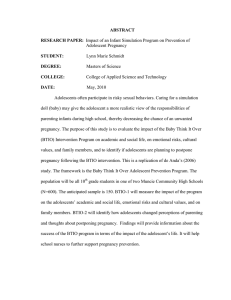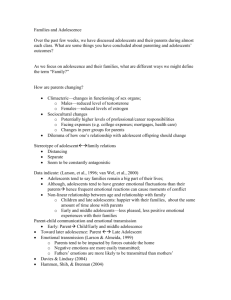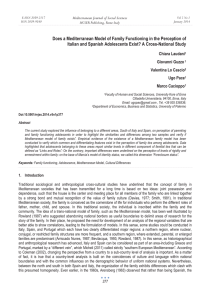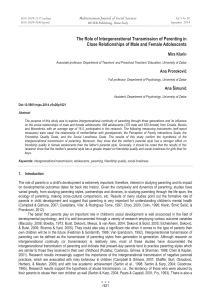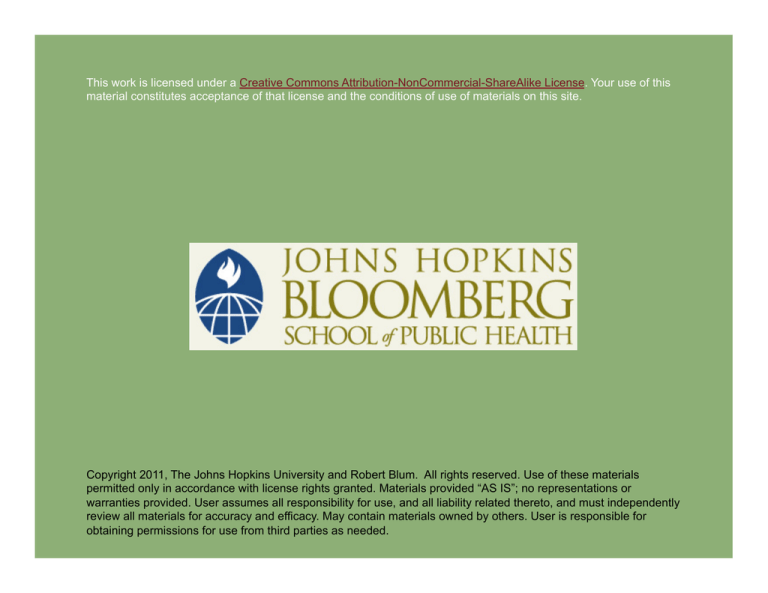
This work is licensed under a Creative Commons Attribution-NonCommercial-ShareAlike License. Your use of this
material constitutes acceptance of that license and the conditions of use of materials on this site.
Copyright 2011, The Johns Hopkins University and Robert Blum. All rights reserved. Use of these materials
permitted only in accordance with license rights granted. Materials provided “AS IS”; no representations or
warranties provided. User assumes all responsibility for use, and all liability related thereto, and must independently
review all materials for accuracy and efficacy. May contain materials owned by others. User is responsible for
obtaining permissions for use from third parties as needed.
Section C
Parenting and Adolescence
Parenting and Adolescent Health
Fundamental components of parenting
- Connection
- Respect for individuality
- Regulation of behavior
Historically, definitions of these components defined with U.S.
samples
- Schaefer (1965)
- Baldwin (1947)
- Baumrind (1971)
- Maccoby & Martin (1983)
Independent contributions of these to specific domains of
adolescent functioning has not systematically studied
3
Parents and Adolescent Health and Development
How Parents Facilitate or Harm Adolescent Health and Development
Establishing a
personal
+
Teaches trust, acceptance, confidence
Social
Competence
CONNECTION
+
–
Applying
PSYCHOLOGICAL
CONTROL
Undermines individual identity and value
–
Mental
Health
+
–
Applying
REGULATION
Teaches self-regulation, protects against
negative influences
Source: This model was developed by Brian K. Barber, University of Tennessee
Antisocial
Behavior
4
Method
12 cultures
Sample of 1,000 14- to 17-year-old, school-going youth in
metropolitan areas
- Samples representative of school districts
Same instrument (translated into nine languages) used in all
sites, assuring comparability of data
5
Map of Research Sites
Bosnia
Germany
Palestine
China
USA—White
India
Bangladesh
Colombia
South
South Africa—Colored
Africa —
White
South Africa—Black
Australia
6
Measures: Connection
My mother or father is a person who . . . (reported separately for mothers and
fathers)
1.
Makes me feel better after talking over my worries with her/him.
2.
Smiles at me very often.
3.
Is able to make me feel better when I am upset.
4.
Enjoys doing things with me.*
5.
Cheers me up when I am sad.*
6.
Gives me a lot of care and attention.*
7.
Makes me feel like the most important person in her/his life.*
8.
Believes in showing her/his love for me.
9.
Often praises me.*
10. Is easy to talk to .”
Response scale: 1 “Not like her/him,” 2 “Somewhat like her/him,” 3 “A lot like
her/him.”
* Items for reduced version; from factor analyses of 1996 and 1997 data. Alphas range between .80
and .89, depending on gender.
Source: Acceptance subscale from the Child Report of Parent Behavior Inventory (CRPBI) (Schaefer,
1965; Schludermann & Schludermann, 1988)
7
Measures: Psychological Control
My mother or father is a person who . . . (reported separately for mothers and
fathers)
1.
Is always trying to change how I feel or think about things.
2.
Changes the subject whenever I have something to say.
3.
Often interrupts me.
4.
Blames me for other family members’ problems.
5.
Brings up past mistakes when s/he criticizes me.
6.
Is less friendly with me if I do not see things her/his way.
7.
Will avoid looking at me when I have disappointed her/him.
8.
If I have hurt her/his feelings, stops talking to me until I please her/him
again.
Response scale: 1 “Not like her/him,” 2 “Somewhat like her/him,” 3 “A lot like
her/him.”
Source: Psychological Control Scale—Youth Self-Report (Barber, 1996)
8
Measures: Regulation
How much does your mother/father really know:
1.
Who your friends are
2.
Where you go at night
3.
How you spend your money
4.
What you do with your free time
5.
Where you are most afternoons after school
Response scale: 1 “Not like her/him,” 2 “Somewhat like her/him,” 3 “A lot like
her/him.”
Source: Parental Monitoring Scale, Brown 1993
9
Summary of Findings
How Parents Facilitate or Harm Adolescent Health and Development
Establishing a
personal
+
Teaches trust, acceptance, confidence
Social
Competence
CONNECTION
+
–
Applying
PSYCHOLOGICAL
CONTROL
Undermines individual identity and value
–
Mental
Health
+
–
Applying
REGULATION
Teaches self-regulation, protects against
negative influences
Source: This model was developed by Brian K. Barber, University of Tennessee
Antisocial
Behavior
10
Cultural Specificity of Connection
It is possible that the salience to human development of
support from caregivers is so profound that it affects all
aspects of child functioning
It is also possible that specific supportive behaviors have
specific effects, and that these supportive behaviors may vary
by culture
A test of this latter hypothesis is important for designing
parenting programs or giving advice to parents
11
C-NAP Open-Ended Question
Tell us four specific things your parents do that make you know
they love you.
12
Parental Behaviors
Most Frequently Reported Parental Behaviors that
Are Perceived as Demonstrating Love (N=4166)
13
Show Physical Affection
Show Physical Affection
14
Do Things with Me
Do Things with Me
15
Buy/Provide Necessities
Buy/Provide Necessities
16
Support Education
Support Education
17
Guide/Advise Me
Guide/Advise Me
18
Demonstrate Respect/ Trust Me
Demonstrate Respect/Trust Me
19
Findings
Adolescents in all cultures perceive encouragement, caring,
and support as a sign of love
Adolescents in all cultures view being given things they want
as a sign of love
- We tend not to measure this
Adolescents perceive provision of a rare commodity as a sign
of love
- These commodities vary by culture
Warmth and support are most frequently mentioned in the
West; guidance and advice in the East
20

